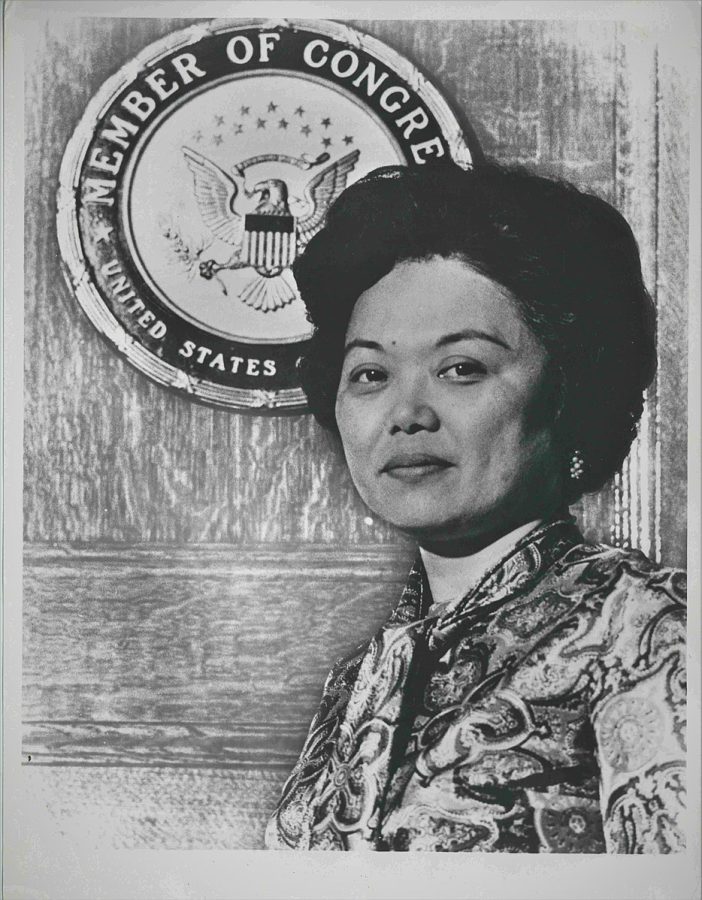Patsy Mink: Activist, Legislator, and Trailblazer
Despite standing at only 5’3”, Patsy Mink was one of the tallest figures in American History. A Sansei American, Mink smashed through the bamboo ceiling, becoming the first ever woman of color in Congress.
Patsy Takemoto Mink was born Patsy Matsu Takemoto on December 6, 1927. She was born the daughter of Suematsu Takemoto, a civil engineer. From the start, Patsy strove for greatness; in 1944, she graduated from Maui High School as class president and valedictorian. She attended the University of Nebraska for her undergraduate studies, where she first met her future husband, John Mink. During her time in college, Mink fought against segregated housing in the University of Nebraska’s fraternities and sororities.
For her graduate studies, Patsy Mink applied to multiple medical schools but was rejected from each. Instead, she decided to attend the University of Chicago Law School to become a lawyer. Mink returned to Hawaii with her husband and daughter, Gwendolyn Mink, where she would pass the bar exam. Although she was fully qualified, Mink was unable to find work due to her interracial marriage. Patsy Mink eventually founded her own practice, becoming the first Japanese-American woman to practice law in Hawaii.
When Hawaii became a state in 1959, Patsy Mink set her sights on politics. She ran for Hawaii’s lone seat in the House of Representatives, but was defeated by Daniel Inouye, who had received endorsement by the Democrat party. Mink settled for a seat in the Hawaii State Senate until 1962, when Hawaii received another seat in the House. Once again, Patsy Mink ran without the support of the Democratic party – but this time, she was victorious. A newfound representative of Hawaii, Mink became the first ever woman of color in Congress.
During her time in office, Patsy Mink maintained a close bond to the people that she represented, fighting passionately for racial and gender equity. Mink traveled back and forth between D.C. and Hawaii every week in order to maintain close relationships with members of her community. Assigned to the Committee of Education and Labor, she fought for bilingual education, women’s rights, and racial equality. In a speech at the National Association for Student Affairs, she said, “We self-righteously expect all others to admire us for our democracy and our traditions. We are so smug about our superiority, we fail to see our own glaring faults, such as prejudice and poverty amidst affluence.”
[Patsy Mink in her office, 1967. Personal collection of Gwendolyn Mink, CC BY]
Always a champion of women’s rights, Mink authored and sponsored Title IX and the Women’s Educational Equity Act. Title IX is a law preventing discrimination in federal education and welfare programs. It states that “No person in the United States shall, on the basis of sex, be excluded from participation in, be denied the benefits of, or be subjected to discrimination under any education program or activity receiving Federal financial assistance.” Later, when Title IX was under attack, Mink pushed for the Women’s Educational Equity Act, which authorized grants in support of Title IX.
Impressed by her dedication and work in office, the Oregon Democrats asked Patsy Mink to run in the 1972 presidential elections. Mink ran with her primary focus on being an antiwar candidate. In one speech she said “My candidacy offers a real and tangible alternative, based—if any one word can be singled out—on humanism.” However, Mink withdrew from the race after receiving only 2% of the vote. After the election, Patsy Mink took a break from office. During her time away, she served as president of the Americans for Democratic Action, and Assistant Secretary of State for Oceans and International Environmental and Scientific Affairs.
In 1990, Patsy Mink made her return to the House of Representatives. Mink ran under the campaign slogan, “The Experience of a Lifetime.” She once again ran without the support of her party–and once again, she won. She rejoined the Committee on Education and Labor and also joined the Natural Resources and Budget Committees. In 1994, Mink co-founded the Congressional Asian Pacific American Caucus, a convention for Asian Americans in Congress. She served as the chairwoman of the caucus from 1995 to 1997.
[American Caucus at a press conference with (left to right) Representatives Don Edwards and Norman Mineta, Guam Delegate Robert Underwood, and Representatives Nancy Pelosi and Neil Abercrombie] by Laura Patterson.]
Patsy Mink passed away September 28, 2002, but her death was not the end of her legacy. Her name was still on the ballot in November, and she won in a landslide victory posthumously. Mink received a stunning 56.16% of the vote. After her death, Title IX was renamed the Patsy T. Mink Equal Opportunity in Education Act, in honor of her legacy. When recounting a WNBA game she had attended with Patsy Mink, Representative Maxine Waters said, “As I looked at all of those strong, tall women out there playing, I thought it was a short, little woman that caused this tall, big woman to be able to realize her dreams.”
Mink achieved a great amount during her time in office. She served a total of 12 terms (24 years) in office. She fought for everyone’s rights, and believed in equal access to education for all. Patsy Mink was a trailblazer who lit the way for politicians for years to come. In a 1976 speech she said, “It is easy enough to vote right and be consistently with the majority, but it is more often more important to be ahead of the majority and this means being willing to cut the first furrow in the ground and stand alone for a while if necessary.”





















Cindy • Dec 6, 2022 at 2:42 PM
Great job! Fantastic article.